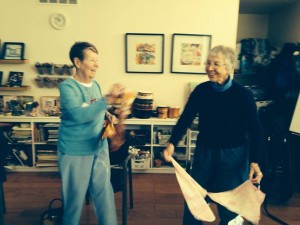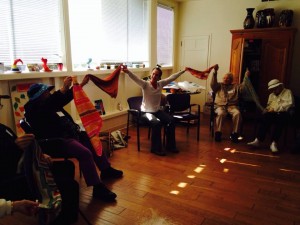Motivational Chair Movement and Music for Elders with Memory Loss
Applying an accumulative knowledge of Dance and Somatic Therapy studies, including the Tamalpa Life-Art Process.
Having a weekly or daily dose of movement and the arts offers the following benefits:
- Ease pain and increase fluidity in the muscles and joints
- Lower anxiety, raise energy level and enhance brain function
- Share in soulful community celebration
- Experience freedom and relaxation in the body through movement modified for each individual’s physical ability


For the last 5 years, I have developed a weekly class for seniors with memory loss in San Rafael, Ca. Working with seniors with dementia, Alzheimer’s disease, stroke, PTSD and other brain disfunction, I have found that creative expression and social connection through movement, music, and drawing enhances wellness in the aging body, mind and spirit.
In a 1-hour class, clients follow simple movement exercises which lifts the pressure off of having to remember words and encourages elders to be in the present moment while connecting to a physical level of awareness.
After introductions and initial hellos, we start with self-massage using the hands to make contact to the head and work our way down through the entire body. Meeting and greeting body parts helping to organize the mind in connection with the body as we become more integrated and present.
We then increase blood flow, fullness of breath, muscle and joint articulation by moving the whole body or isolating body parts in spacial patterns with supportive music. The movement includes body-halves, cross-lateral movement, upper/lower half, radiation movement from the core out to the distal points of the limbs, head-tail connection, directional changes, twisting, folding, reaching, pushing, rotating etc… We also include movement quality changes such as floating, swinging, dangling, pressing, softening or shooting out.
To enhance physical, emotional and mental levels of awareness, I make sure to give a lot of permission for silliness and incorporate a lot of descriptive creative imagery. This, along with functional movement language and constant orientation to what and why we are doing the activity makes it easy, accessible and enjoyable. For example:
- “Pulling apples from the tree”– 1 arm at a time reaching way up, grabbing and pulling down…Clients can also say what other fruits we are picking and the movement may change according to the fruit if we pick. ie. a watermelon or picking strawberries reaches down. If we feel like eating it or sharing it with the others that is another playful approach.
- There may also be an emotional quality to the movement if I say, “hold the arms out to the side with palms up. Feel this ‘welcoming posture’….take a breath in and out”. Now bring the arms in and give yourself a hug… Rocking back and forth”.
- Also, to honor and respect their intelligence, I often add anatomical references to health benefits. While we are tapping the chest and saying “ahhhhhhh”, for example, I may say “this helps open the throat and support the limbic system. Or I may encourage them to roll/point/flex the ankles for more flexibility and strength “to avoid shuffling when we walk or falling as we get older”.
It is important to engage the mind in multiple ways while leading folks with different levels of memory loss and physical ability. Clients with Dementia and Altzheimer’s disease need a lot of reassurance, loving comments to disarm any paranoia/fear/self doubt and non-judgemental encouragement is required. Clients are reminded to rest if they feel tired, go at their own pace, adapt the movement for their own range of motion and are sometimes guided by me with hands-on support in stretches or movement with their permission.
The movement part of class is mainly seated in chairs, and can include dancing with scarves, tossing/kicking a ball or moving while standing for those who are able. It is important to offer options to provide accessibility to everyone…even those who are so far along with the disease that they are only able to observe.
Humor, fun, repetition and improvisation are key components for this population. Keep it light. I always include some sort of partnering weather it is simple eye contact or a smile to the person next you, touching open hands as a greeting, holding hands in a circle while swinging them up, or reaching to the person across from you during a stretch. Responding to their own funny comments in a light and agreeable way, incorporating them into the class again and again. Noticing if there is a different movement one person is doing and following them for a while. If there is sadness…. we offer a hug and comforting words. If there is anger…redirect / de-escalate don’t ignore. The class is not only about exercise but about creating safety and feeling human again. It is important to have assistants in the room to help with individuals.
I usually finish the class with a meditative rest and invite participants to listen to the relaxing sound of my cedar flute.
If we have a longer session of 1.5 hrs., I will add other modalities like singing, drawing or simple games. Joining in circle singing with hand percussion instruments brings up long-term memory recognition for this population. The social engagement seems to offer comfort and ease for those who may have anxiety or for those who are loosing an ability to be verbally social.
Drawing thematic images from nature, seasonal themes, memory of place, family etc..or letting the client draw abstract designs allows another area of the brain to come forth with color, shape, and symbolic meaning. It is a time for individual attention with each client and an opportunity to have conversations about what images and stories emerge. I may have a group share at the end for folks to see what others have drawn.
Pingback: SAVE THE DATE for ¡FLACC! 2015 | Elizabeth Duran Boubion, MFA, RSMT